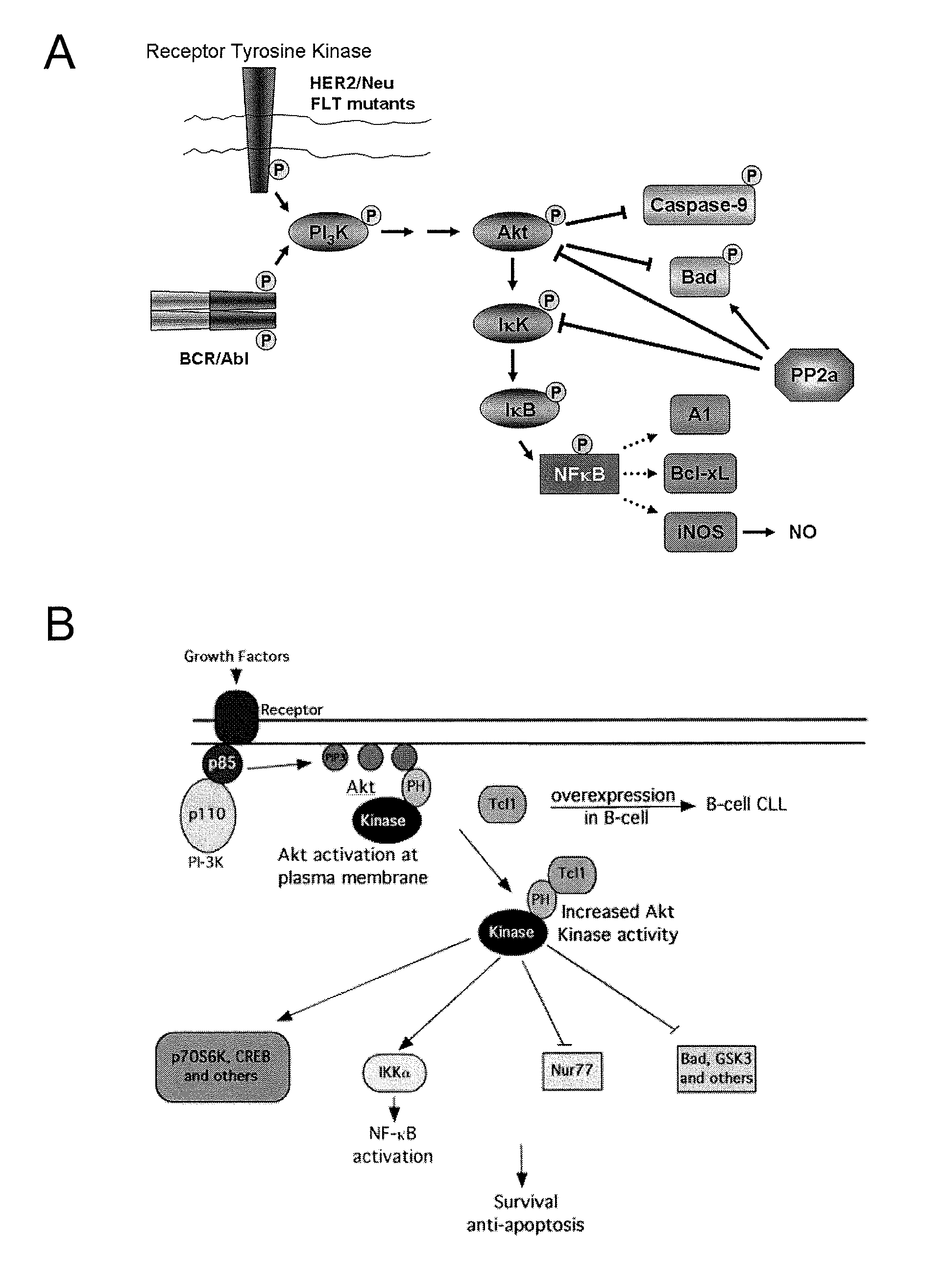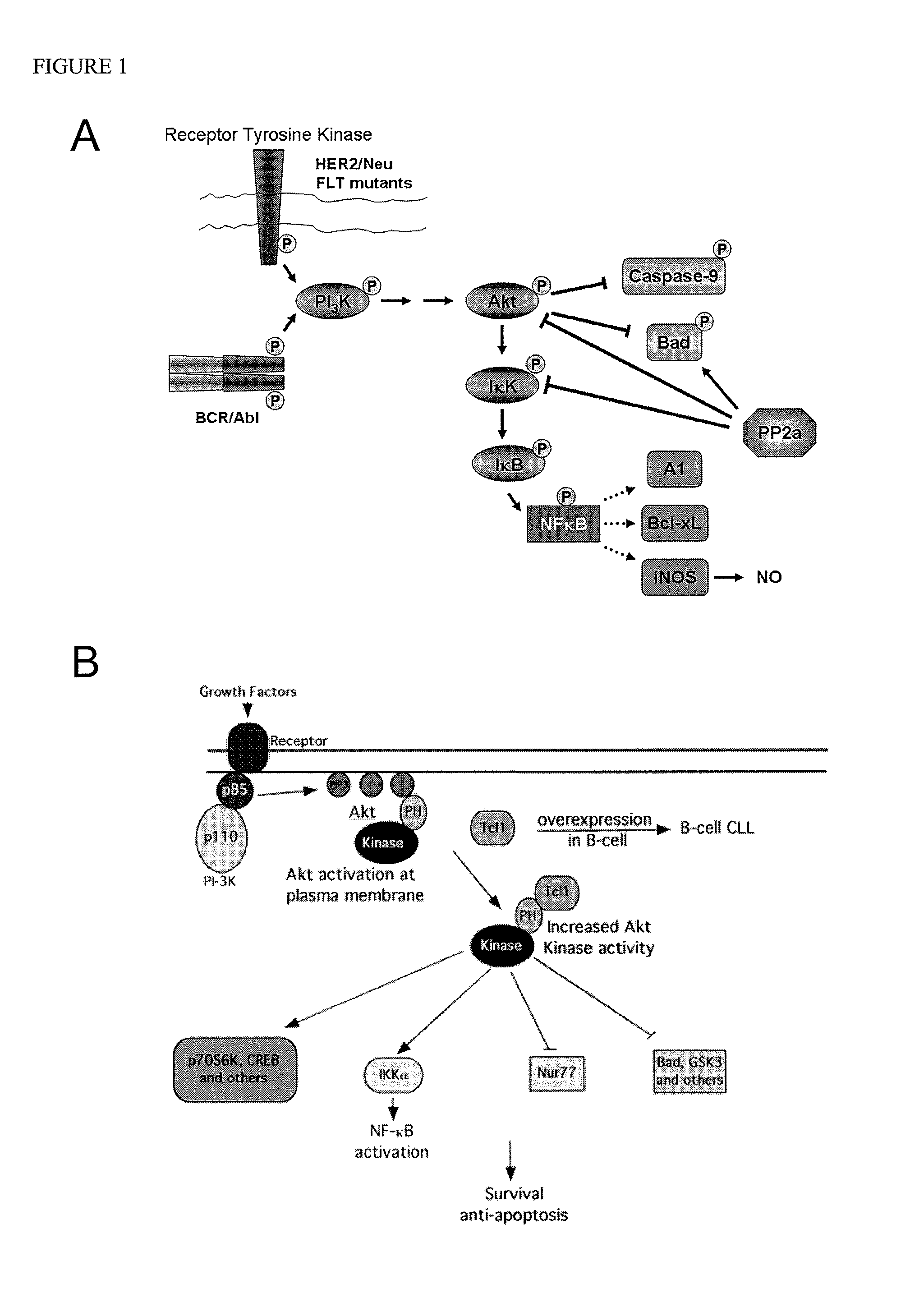Methods of treating cancer with apoe peptides
a technology of apoe peptides and cancer, applied in the field of cancer treatment, can solve the problems of limited efficacy, adverse side effects, and limited efficacy of eliminating cancerous tissue by surgical removal of tumors, and achieve the effects of significant cll pathology, enhanced akt activity, and potent and selective cytotoxic activity
- Summary
- Abstract
- Description
- Claims
- Application Information
AI Technical Summary
Benefits of technology
Problems solved by technology
Method used
Image
Examples
example 1
COG Peptides Modulate the Akt / NFκB Pathway
[0046]Many types of cancer feature aberrant, constitutive activation of the phosphatidylinositol-3 Kinase (PI-3K) / Akt pathway, which results in establishment of an anti-apoptotic environment in the cancer cell that correlates with poor outcome. When growth factors such as insulin activate the PI3 Kinase at the plasma membrane, phosphoinositides are phosphorylated leading to the translocation of Akt to the plasma membrane where it is activated by phosphorylation at Thr308 and Ser473. Once activated, Akt regulates proteins that are essential for cell survival through two mechanisms (FIG. 1). First, Akt can regulate survival proteins by controlling the function of these survival proteins through kinase-mediated activation or inhibition. It has been demonstrated that activated Akt directly phosphorylates caspase-9 and Bad thereby inactivating them. Caspase-9 is a protease that is activated early in the normal apoptosis cascade, while Bad is a pr...
example 2
COG112 activates PP2A
[0053]Mouse macrophagic RAW cells were incubated with either 2 μM COG112 (SEQ ID NO: 2), 10 nM okadaic acid (an inhibitor of PP2A), or okadaic acid and COG112. After 30 minutes, cells were lysed and PP2A was immunoprecipitated by adding an antibody targeted to the catalytic C-subunit of PP2A. Half of the immunoprecipitate was separated by SDS-PAGE, blotted on to nitrocellulose, and probed with an anti-PP2AC antibody. The remaining portion was assayed for activity by adding 125 μL assay cocktail containing a phospho-threonine substrate peptide to the immunoprecipitated enzyme. After incubating at 37° C. with shaking, a 25 μL aliquot was removed and added to an ammonium molybdate solution (Upstate) that chelates free phosphate and changes color upon chelate formation. Aliquots were removed at various time intervals and the amount of free phosphate released from the peptide was determined by comparison to a phosphate standard curve. The rate of phosphate release wa...
example 3
COG112 Kills B-CLL Cells in vitro
[0054]The persistent anti-apoptotic state of B-cells in chronic lymphocytic leukemia (B-CLL) is thought to be due, in part, to an overactivation of the Akt / NFκB signaling cascade. PP2A is known to counterbalance this signaling pathway by dephosphorylating and inactivating Akt kinase and IκK kinase (Kuo et al. (2008) J Biol Chem., Vol. 283: 1882-1892; Kray et al. (2005) J Biol Chem., Vol. 280: 35974-82). PP2A can also regulate apoptosis pathways by dephosphorylating and activating caspases, which play an early role in the induction of apoptosis. Thus, compromised PP2A activity in a cell would contribute to the constitutive activation of the Akt pathway preserving the anti-apoptotic state. In fact, a deletion at 11g22-q23, which includes a portion of the PPP2R1B gene, represents the second most common chromosomal aberration in B-CLL. The PPP2R1B gene encodes the Aβ constant regulatory subunit of PP2A, commonly known as a tumor suppressor. This deletion...
PUM
| Property | Measurement | Unit |
|---|---|---|
| pH | aaaaa | aaaaa |
| time | aaaaa | aaaaa |
| frequency | aaaaa | aaaaa |
Abstract
Description
Claims
Application Information
 Login to View More
Login to View More - R&D
- Intellectual Property
- Life Sciences
- Materials
- Tech Scout
- Unparalleled Data Quality
- Higher Quality Content
- 60% Fewer Hallucinations
Browse by: Latest US Patents, China's latest patents, Technical Efficacy Thesaurus, Application Domain, Technology Topic, Popular Technical Reports.
© 2025 PatSnap. All rights reserved.Legal|Privacy policy|Modern Slavery Act Transparency Statement|Sitemap|About US| Contact US: help@patsnap.com



